Jud Fine and Barbara McCarren’s And/Or show at the University Art Museum, Cal State University Long Beach channels us toward Keats’ notion of negative capability, or a fertile surrender to paradox and uncertainty, by way of two colliding currents. One induces nostalgic reverie with emblems of childhood and domesticity, and the other a likewise agreeable trance through reiterations of a clear formal aesthetic. We are lulled along both routes by the charms of conceptual clarity, cultural familiarity, and repetition as respective proxies for knowing, experience, and evidence. Where the currents cross and can no longer carry us forward, we can choose to hold fast to systematicity or sentimentality and tread in circles, or we can plunge into the murk of their shared referent, i.e., the continental edge, which is neither an object nor a state, but a harbor of infinite possibilities for coalescence through generative opposition.
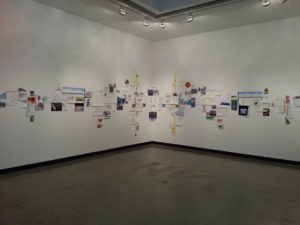
Jud Fine and Barbara McCarren, Wall Composite I (2013-2015). Photo by Jennie E. Park.
Wall Composite I (2013-2015) presents a collage of the artists’ photographs, sketches, and notes that evolved into the pieces in the show. The assemblage points to domestic rituals of remembering—scrapbooking, collaging, even cave drawing—that induce nostalgia, not only vicariously for the artists’ memories, but more broadly for our instinctual practice of preserving our feelings around a referent that is always receding. Although no visitor to the show will have experienced a lifetime with nature unmediated by electronics or machinery, we viscerally believe that as a species we once have.
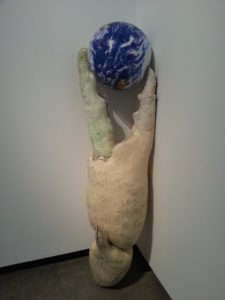
Jud Fine and Barbara McCarren, Callinectics (Meat) (2015). Photo by Jennie E. Park.
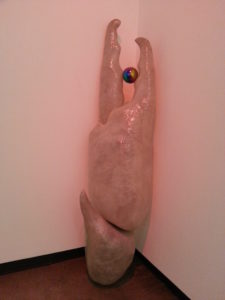
Jud Fine and Barbara McCarren, Callinectics (Shell) (2016). Photo by Jennie E. Park.
This fabricated primal memory is also held by Callinectes (Meat) (2015) and (Shell) (2016), two pincers appearing as stuffed toys and standing metonymically for the entire organism at either end of Wall Composite I, and Dazzle Ship (2016), the filing cabinet of ideas for the show that promises traceability and comprehensibility. We arrive at our primal memory by way of these objects that remind us of home (and thus, Home). Their shorthand and finite natures, and the conventions of art exhibition that prevent us from handling them, ultimately render them merely seductive symbols that obstruct rather than enduringly explicate and harness what we long to recall or know.

Jud Fine and Barbara McCarren, Buoys of Calais (2016). Photo by Jennie E. Park.
Bop Buoys (2014-2016), Buoys of Calais (2016), and Boat to Bird I (2014-2016), also inspired by childhood toys, at once invite and confront us with their size and transparency. While variable in dimension, the buoys underscore seriality, and the boats ballasting each other boast symmetry and balance. Both thus romanticize or idealize our tumult with nature through aesthetic formalism. We are convinced that the buoys, by design, will bounce back from the beating of wind or waves, and that capsized boats hurled aloft will elegantly take flight. Never mind that a pin prick could deflate the buoys and that the wire frame boats could never float—their apparent lightness, clarity, and aesthetic integrity are more persuasive than the efficacy of their materials. In the same way, our modern aloof relationship to nature fails to fathom the fragility of its deceptively dense materiality.
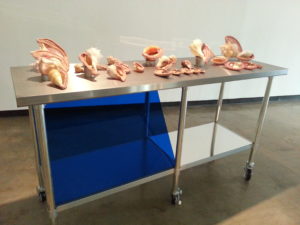
Jud Fine and Barbara McCarren, Ear Shells (2011-2016). Photo by Jennie E. Park.
The show’s tangible referents—the sea, the sand—are markedly absent; there are no wild and raw piles of actual wreckage. The seams of the boats and buoys are crisp, the glue invisible, and the knots tidy and methodical. The Ear Shells (2011 – 2016) are carefully arrayed on a stainless steel cart above sleek planes of pigment standing in for cool and warm, as though the entire display had just been removed from an autoclave. Although the seashells appear real, they, like the pincers, are serial metonyms for our memory of our relationship with nature, or how the ocean sounds to us. There is no evidence that any of the shells ever touched either side of a shore, or that any attached ear ever belonged to one of us. They represent and contain only symbolic echoes.
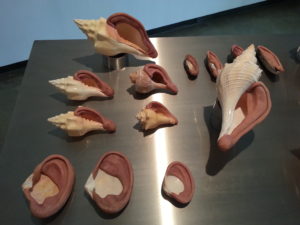
Jud Fine and Barbara McCarren, Ear Shells (2011-2016) (detail). Photo by Jennie E. Park.
So we arrive at the ultimate failure of primal memory or systems of cataloguing or ordering to resolve our distressed relationship to the expanse of land and sea. As McCarren/Fine arrive at collaboration in their studio practices through opposition, this show advocates for similarly productive and truthful opposition. Our production of and reaction to climate change is in danger of tracking the limited masculine/feminine dynamic of conqueror/victim: We believe we have decimated nature and therefore must save it, while forgetting that nature has proven its capacity to catastrophically mar itself without our assistance and that we, entering land or sea defenseless, would be instantly devoured. We need a sound hull to oppose the waves, or, at the very least, the conscious intention and direction of our bodies to float. We and nature do not instinctively have each other’s backs. As vertical successors to our primitive ancestors, capable of conceiving of states of “And” and “Or,” we are in fact the slash in the show’s title. Recognizing our inherent capability to hyphenate and divide at once, we are challenged to inventively wrestle with the contemporary continental edge beyond the bounds of our familiar feelings and systems, and, most urgently, beyond the museum’s walls.


